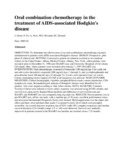| dc.description.abstract | OBJECTIVES: To determine the effectiveness of an oral combination chemotherapy regimen administered to patients with AIDS-associated Hodgkin's disease. DESIGN: Prospective, pilot phase II clinical trial. SETTING: Consecutive patient recruitment occurred at two medical centers in the United States: Albany Medical Center, Albany, New York, where patients were recruited prior to December 31, 1996 (pre-HAART era); and University Hospitals of Cleveland, Cleveland, Ohio, where patients were recruited after January 1, 1997 (HAART era). INTERVENTION: Oral chemotherapy consisted of lomustine (100 mg/m2 day I for cycle one and odd cycles thereafter); etoposide (200 mg/m2 days 1 through 3); and cyclophosphamide and procarbazine (each 100 mg/m2 days 22 through 31). Cycles were repeated every six weeks. Colony-stimulating factor support (G-CSF in all instances) was allowed. MAIN OUTCOME MEASURES: Clinical demographic variables, peripheral blood counts, serum chemistries, CD4 lymphocyte count, histopathological subtype of Hodgkin's disease were identified for all patients, who were staged according to Ann Arbor criteria. DATA ANALYSIS: Common Toxicity Criteria were utilized to assess safety; response was assessed using ECOG criteria; and survival was analyzed by Kaplan-Meier methods and difference of survival between pre-HAART and HARART era was compared using log-rank test. RESULTS: Eleven patients (six in pre-HAART era), all but one male, with a median age of 36 years, excellent performance status and advanced International Prognostic Score were treated. Myelosuppression was the major side effect and there were minimal other grade 3 or greater toxicity all of which were promptly reversible. An overall objective response rate of 82% (with 18% complete responses) and median survival duration of 24 months (range 2.5 +/- 68) were observed. Survival was markedly improved in patients treated in the HAART era (median not reached versus 7.25 months. | en |

